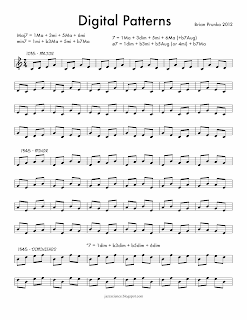These are mostly drop-2 chords, so unlike Evans's close voicings, these are open voicings. This does change the character of the sonority considerably; if the aspect of Evans's voicings that you want to imitate is the crunch of the 2nd, then the close voicings in the previous post or 3-note voicings would be more appropriate. That consideration aside, these are very useful and hip-sounding voicings.
Perhaps I'll deal with a 3-note voicing approach in some future post.
Again, I've arranged these in the context of a II V I progression to clarify the voice leading and usage.
See my notes from the previous post for more details.
These are all on the 1234 string set, but most of these can be translated to the 2345 string set. You can do this yourself (it's a great way to learn), or wait a few days and I'll post the 2345 voicings.
 |
| Bill Evans Rootless Guitar voicings, 1234 string set, page1 |
 |
| Bill Evans Rootless Guitar voicings, 1234 string set, page 2 |
 | |
| Bill Evans Rootless Guitar voicings, 1234 string set, page 3 |
At this point, you may be wondering about the directive that the voicings must have either the 3rd or 7th (or 6th) on the bottom.
The main reason for this is that without the root motion, the 3rds and 7ths provide the clearest definition of the chord sound; having them on the bottom just makes it sound stronger. However, the reality is that you may sometimes prefer to voice another note on the bottom; the alternatives obviously are 1 (or 9) and 5 (or 6).
Interestingly, if you alternate all 3rds and 7ths, or all roots and 5ths, you end up with smooth descending voice leading through circle of 5ths progressions.
If instead, you mix them, you can create interesting contours, some ascending and others descending.
For instance, 3579 to 1367 to 5793 to 3579 creates a general upward movement instead of downward.
Also, when comping, the general downward trend of tonal voice-leading means you eventually either run out of fretboard (or keyboard), or you have to break the voice-leading by leaping upward occasionally. There are a few ways to smooth this out.
One is to make the leaps after cadences, where they are less disruptive (e.g., ii7 V7 I VI7, you leap to the VI7, not to the V7 or I, so that the cadence has smooth voice-leading).
The other is to make judicious use of inversions that lead upward once in a while—for this, the voicings with the 1, 9 or 5 on the bottom are most useful.
I suggest mastering a substantial portion of the voicings with the 3rd and 7th on the bottom before messing with the others.





